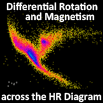Speaker
Reinhard Schlickeiser
(Inst. f. Theoretische Physik, Ruhr-Universitaet Bochum)
Description
Magnets have practically become everyday objects. Permanent
ferromagnetism is a property of only a few densely packed
materials, such as iron, in which the spin exchange interactions of
individual atoms naturally line up in the same direction and
create a residual persistent magnetic field. In the early universe,
before iron and other magnetic materials had been created inside
stars, such permanent magnetism did not exist. Scientists have
long wondered where the observed cosmic magnetization came
from, given that the fully ionized gas of the early universe
contained no ferromagnetic particles. Many astrophysicists
believe that galactic magnetic fields are generated and
maintained by dynamo action, whereby the energy associated
with the differential rotation of spiral galaxies is converted into
magnetic field energy. However, the dynamo mechanism is only a
means of amplification, and dynamos require seed magnetic
fields. Neither the dynamo process nor plasma instabilities
generate magnetic fields out of nothing: they need
finite seed fields to start from.
In the talk it is shown that an unmagnetized nonrelativistic
thermal electron-proton plasma spontaneously emits aperiodic
turbulent magnetic field fluctuations of strength |delta B|=3.5
beta_e g^(1/3) W_e^(1/2) G, where beta_e is the normalized
thermal electron temperature, W_e the thermal plasma energy
density and g the plasma parameter. For the unmagnetized
intergalactic medium, immediately after the reionization onset,
the field strengths from this mechanism are about 2 x 10^(-16) G
in cosmic voids and 2 x 10^(-10) G in protogalaxies, both too
weak to affect the dynamics of the plasma. Accounting for
simultaneous viscous damping reduces these estimates to 2
x 10^(-21) G in cosmic voids and 2 x 10^(-12) G in protogalaxies.
The shear and/or compression of the intergalactic and
protogalactic medium exerted by the first supernova explosions
locally amplify these seed fields and make them anisotropic,
until the magnetic restoring forces affect the gas dynamics at
ordered plasma betas near unity.
Author
Reinhard Schlickeiser
(Inst. f. Theoretische Physik, Ruhr-Universitaet Bochum)

